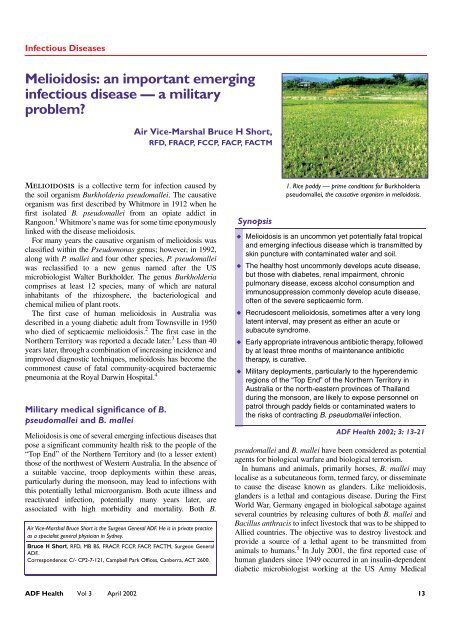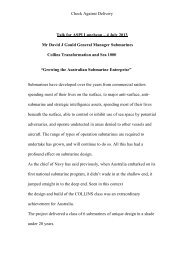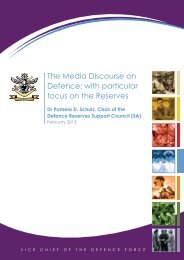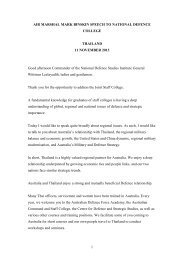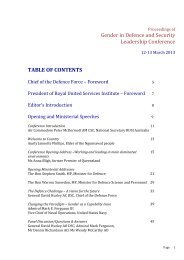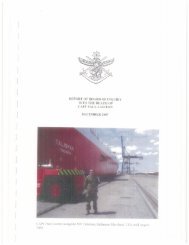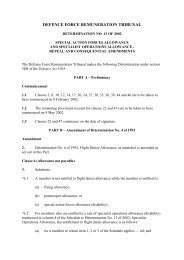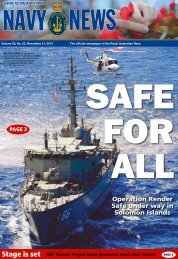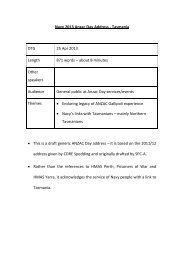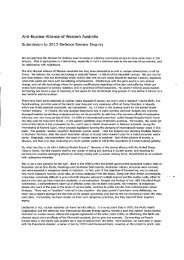Melioidosis: an important emerging infectious disease — a military ...
Melioidosis: an important emerging infectious disease — a military ...
Melioidosis: an important emerging infectious disease — a military ...
Create successful ePaper yourself
Turn your PDF publications into a flip-book with our unique Google optimized e-Paper software.
Infectious Diseases<br />
<strong>Melioidosis</strong>: <strong>an</strong> import<strong>an</strong>t <strong>emerging</strong><br />
<strong>infectious</strong> <strong>disease</strong> <strong>—</strong> a <strong>military</strong><br />
problem?<br />
ADF Health ISSN: 1443-1033 April 2002 3 1 13-21<br />
MELIOIDOSIS is a collective term for infection caused by<br />
the soil ©ADF org<strong>an</strong>ism Health 2002 Burkholderia pseudomallei. The causative<br />
org<strong>an</strong>ism INFECTIOUS was first DISEASES described by Whitmore in 1912 when he<br />
first isolated B. pseudomallei from <strong>an</strong> opiate addict in<br />
R<strong>an</strong>goon. 1 Whitmore’s name was for some time eponymously<br />
linked with the <strong>disease</strong> melioidosis.<br />
For m<strong>an</strong>y years the causative org<strong>an</strong>ism of melioidosis was<br />
classified within the Pseudomonas genus; however, in 1992,<br />
along with P. mallei <strong>an</strong>d four other species, P. pseudomallei<br />
was reclassified to a new genus named after the US<br />
microbiologist Walter Burkholder. The genus Burkholderia<br />
comprises at least 12 species, m<strong>an</strong>y of which are natural<br />
inhabit<strong>an</strong>ts of the rhizosphere, the bacteriological <strong>an</strong>d<br />
chemical milieu of pl<strong>an</strong>t roots.<br />
The first case of hum<strong>an</strong> melioidosis in Australia was<br />
described in a young diabetic adult from Townsville in 1950<br />
who died of septicaemic melioidosis. 2 The first case in the<br />
Northern Territory was reported a decade later. 3 Less th<strong>an</strong> 40<br />
years later, through a combination of increasing incidence <strong>an</strong>d<br />
improved diagnostic techniques, melioidosis has become the<br />
commonest cause of fatal community-acquired bacteraemic<br />
pneumonia at the Royal Darwin Hospital. 4<br />
Military medical signific<strong>an</strong>ce of B.<br />
pseudomallei <strong>an</strong>d B. mallei<br />
Air Vice-Marshal Bruce H Short,<br />
RFD, FRACP, FCCP, FACP, FACTM<br />
<strong>Melioidosis</strong> is one of several <strong>emerging</strong> <strong>infectious</strong> <strong>disease</strong>s that<br />
pose a signific<strong>an</strong>t community health risk to the people of the<br />
“Top End” of the Northern Territory <strong>an</strong>d (to a lesser extent)<br />
those of the northwest of Western Australia. In the absence of<br />
a suitable vaccine, troop deployments within these areas,<br />
particularly during the monsoon, may lead to infections with<br />
this potentially lethal microorg<strong>an</strong>ism. Both acute illness <strong>an</strong>d<br />
reactivated infection, potentially m<strong>an</strong>y years later, are<br />
associated with high morbidity <strong>an</strong>d mortality. Both B.<br />
Air Vice-Marshal Bruce Short is the Surgeon General ADF. He is in private practice<br />
as a specialist general physici<strong>an</strong> in Sydney.<br />
Bruce H Short, RFD, MB BS, FRACP, FCCP, FACP, FACTM, Surgeon General<br />
ADF..<br />
Correspondence: C/- CP2-7-121, Campbell Park Offices, C<strong>an</strong>berra, ACT 2600.<br />
Synopsis<br />
1. Rice paddy <strong>—</strong> prime conditions for Burkholderia<br />
pseudomallei, the causative org<strong>an</strong>ism in melioidosis.<br />
◆ <strong>Melioidosis</strong> is <strong>an</strong> uncommon yet potentially fatal tropical<br />
<strong>an</strong>d <strong>emerging</strong> <strong>infectious</strong> <strong>disease</strong> which is tr<strong>an</strong>smitted by<br />
skin puncture with contaminated water <strong>an</strong>d soil.<br />
◆ The healthy host uncommonly develops acute <strong>disease</strong>,<br />
but those with diabetes, renal impairment, chronic<br />
pulmonary <strong>disease</strong>, excess alcohol consumption <strong>an</strong>d<br />
immunosuppression commonly develop acute <strong>disease</strong>,<br />
often of the severe septicaemic form.<br />
◆ Recrudescent melioidosis, sometimes after a very long<br />
latent interval, may present as either <strong>an</strong> acute or<br />
subacute syndrome.<br />
◆ Early appropriate intravenous <strong>an</strong>tibiotic therapy, followed<br />
by at least three months of mainten<strong>an</strong>ce <strong>an</strong>tibiotic<br />
therapy, is curative.<br />
◆ Military deployments, particularly to the hyperendemic<br />
regions of the “Top End” of the Northern Territory in<br />
Australia or the north-eastern provinces of Thail<strong>an</strong>d<br />
during the monsoon, are likely to expose personnel on<br />
patrol through paddy fields or contaminated waters to<br />
the risks of contracting B. pseudomallei infection.<br />
ADF Health 2002; 3: 13-21<br />
pseudomallei <strong>an</strong>d B. mallei have been considered as potential<br />
agents for biological warfare <strong>an</strong>d biological terrorism.<br />
In hum<strong>an</strong>s <strong>an</strong>d <strong>an</strong>imals, primarily horses, B. mallei may<br />
localise as a subcut<strong>an</strong>eous form, termed farcy, or disseminate<br />
to cause the <strong>disease</strong> known as gl<strong>an</strong>ders. Like melioidosis,<br />
gl<strong>an</strong>ders is a lethal <strong>an</strong>d contagious <strong>disease</strong>. During the First<br />
World War, Germ<strong>an</strong>y engaged in biological sabotage against<br />
several countries by releasing cultures of both B. mallei <strong>an</strong>d<br />
Bacillus <strong>an</strong>thracis to infect livestock that was to be shipped to<br />
Allied countries. The objective was to destroy livestock <strong>an</strong>d<br />
provide a source of a lethal agent to be tr<strong>an</strong>smitted from<br />
<strong>an</strong>imals to hum<strong>an</strong>s. 5 In July 2001, the first reported case of<br />
hum<strong>an</strong> gl<strong>an</strong>ders since 1949 occurred in <strong>an</strong> insulin-dependent<br />
diabetic microbiologist working at the US Army Medical<br />
ADF Health Vol 3 April 2002 13
Research Institute for Infectious Diseases, contracted presumably<br />
via tr<strong>an</strong>scut<strong>an</strong>eous puncture with infected material. 6<br />
Although melioidosis is clinically <strong>an</strong>d pathologically<br />
similar to gl<strong>an</strong>ders <strong>disease</strong>, the ecology <strong>an</strong>d epidemiology of<br />
the two are entirely different. Unlike gl<strong>an</strong>ders, <strong>an</strong>imals do not<br />
appear to represent a reservoir for the tr<strong>an</strong>smission of hum<strong>an</strong><br />
melioidosis.<br />
Epidemiology of melioidosis<br />
<strong>Melioidosis</strong> is primarily a <strong>disease</strong> of the tropics (the region<br />
between the Tropic of C<strong>an</strong>cer, 23.5N, <strong>an</strong>d the Tropic of<br />
Capricorn, 23.5S). Within the tropics, there are two areas<br />
where melioidosis may be the most import<strong>an</strong>t bacterial hum<strong>an</strong><br />
pathogen: the Top End region of the Northern Territory in<br />
Australia <strong>an</strong>d some northeastern provinces of Thail<strong>an</strong>d. These<br />
two regions may be considered “hyperendemic” for melioidosis.<br />
7<br />
Almost all cases of melioidosis diagnosed in temperate<br />
climates have been imported from the tropics, with the<br />
exception of a unique outbreak in Fr<strong>an</strong>ce in the mid-1970s. 8<br />
This occurred in <strong>an</strong>imals in the Paris zoo <strong>an</strong>d spread to other<br />
zoos <strong>an</strong>d equestri<strong>an</strong> clubs in Fr<strong>an</strong>ce. 9 In 2000, the first Finnish<br />
case (presenting as a urinary tract infection) was reported in a<br />
previously healthy male tourist. 10<br />
In the past decade reports of <strong>disease</strong> in both hum<strong>an</strong>s <strong>an</strong>d<br />
<strong>an</strong>imals have increased from countries outside the tropics. A<br />
Taiw<strong>an</strong>ese report documents the steady rise of meliodosis in<br />
that country, with 17 infections diagnosed between 1982 <strong>an</strong>d<br />
2000. 11 Other countries reporting melioidosis include China,<br />
especially Hong Kong, Brunei, India, Sri L<strong>an</strong>ka, B<strong>an</strong>gladesh,<br />
Pakist<strong>an</strong> <strong>an</strong>d the Philippines. Sporadic cases have also been<br />
reported from the Caribbe<strong>an</strong>, Central <strong>an</strong>d South America,<br />
Africa <strong>an</strong>d the Middle East. The increasing worldwide<br />
reporting of melioidosis underscores <strong>an</strong> <strong>emerging</strong> global<br />
problem. The highest number of infections are reported from<br />
Thail<strong>an</strong>d (with <strong>an</strong> estimated 2000–3000 cases each year), 12<br />
Malaysia, Singapore <strong>an</strong>d northern Australia. Similar to the<br />
experience in Australia, in northeastern Thail<strong>an</strong>d 20% of<br />
community-acquired septicaemia is caused by melioidosis. 13<br />
The average <strong>an</strong>nual incidence of melioidosis in the Top End<br />
of the Northern Territory between 1989 <strong>an</strong>d 1998 was 16.5 per<br />
100 000, with a rate of 34.5 per 100 000 for the year sp<strong>an</strong>ning<br />
the heavy <strong>an</strong>d prolonged 1997–1998 monsoon. 14 This<br />
compares with <strong>an</strong> <strong>an</strong>nual incidence of 4.4 per 100 000 in the<br />
Ubon Ratchat<strong>an</strong>i Province in northeastern Thail<strong>an</strong>d. 15<br />
Between 1987 <strong>an</strong>d 1994, 23 cases of melioidosis were<br />
diagnosed in serving members of the Singapore Armed<br />
Forces (SAF), with four deaths (17%). Unlike similar cases in<br />
the general community, most cases in the SAF occurred in<br />
otherwise fit <strong>an</strong>d healthy young servicemen. 16<br />
<strong>Melioidosis</strong> has been <strong>an</strong> import<strong>an</strong>t cause of morbidity <strong>an</strong>d<br />
mortality in foreign troops fighting in South East Asia. One<br />
report lists at least 100 cases among French troops in<br />
Indochina between 1948 <strong>an</strong>d 1954, 17 <strong>an</strong>d <strong>an</strong>other 343 cases in<br />
Americ<strong>an</strong> forces fighting in Vietnam by the year 1973. 9<br />
<strong>Melioidosis</strong> has the propensity to remain quiescent for a very<br />
long time <strong>an</strong>d, like tuberculosis, may be reactivated months or<br />
years later. As there are <strong>an</strong> estimated 225 000 Vietnam<br />
veter<strong>an</strong>s who are serologically positive for melioidosis, the<br />
potential for reactivated <strong>disease</strong> has been termed “the<br />
Vietnamese time bomb”. 18 Disease reactivation still occurs in<br />
Vietnam veter<strong>an</strong>s, but fortunately it is rare compared with the<br />
numbers exposed. 19 In one case report, pulmonary melioidosis<br />
was reactivated in a subject with bronchogenic carcinoma<br />
26 years after original exposure. 20 A second report involved a<br />
76-year-old Vietnam veter<strong>an</strong> who presented with B. pseudomallei<br />
osteomyelitis 18 years after exposure <strong>an</strong>d 10 years after<br />
a missed diagnosis of latent pulmonary <strong>disease</strong>. 21 Another<br />
case involved septicaemic melioidosis following acute<br />
influenza A infection six years after exposure in Vietnam. 22<br />
<strong>Melioidosis</strong> is typically distributed unevenly within<br />
endemic areas. The hyperendemicity of northeastern Thail<strong>an</strong>d<br />
constrasts with central Thail<strong>an</strong>d, where only a few cases of<br />
melioidosis have been reported. A closely related but nonvirulent<br />
org<strong>an</strong>ism with similar morphology <strong>an</strong>d <strong>an</strong>tigenicity to<br />
the virulent B. pseudomallei is found in these soils, <strong>an</strong>d it has<br />
recently been named B. thail<strong>an</strong>densis.<br />
Closer to the Australi<strong>an</strong> mainl<strong>an</strong>d, the incidence of<br />
melioidosis in East Timor is unknown, largely due to the<br />
effects of the recent political upheavals. Recent monitoring of<br />
refugees, peace keepers <strong>an</strong>d aid workers returning from East<br />
Timor has been based at Darwin. In contrast to the numerous<br />
cases of dengue, malaria <strong>an</strong>d tuberculosis, there have been no<br />
reported cases of melioidosis. 7<br />
Case reports from Papua New Guinea indicate that<br />
melioidosis is very uncommon in Central Province <strong>an</strong>d the<br />
national referral hospital in Port Moresby, but there may be<br />
other endemic locations in the country where the extent of the<br />
<strong>disease</strong> has yet to be documented. This focal endemicity is<br />
well known in northern Australia, with less <strong>disease</strong> in the<br />
Kimberley (in the far northwest) th<strong>an</strong> in the adjacent Top<br />
End. 23<br />
Microbiological <strong>an</strong>d tr<strong>an</strong>smission data<br />
B. pseudomallei is <strong>an</strong> environmental saprophyte isolated from<br />
wet soils, agricultural soils, streams, pools, stagn<strong>an</strong>t water<br />
<strong>an</strong>d, in particular, paddy fields throughout the endemic areas.<br />
In m<strong>an</strong>y countries, B. pseudomallei is so prevalent that it is a<br />
common contamin<strong>an</strong>t found in laboratory cultures. 24<br />
Although in most cases there is no obvious portal of entry,<br />
such as <strong>an</strong> infected skin abrasion or wounds, the commonest<br />
route of <strong>disease</strong> tr<strong>an</strong>smission is nonetheless by direct<br />
inoculation of contaminated soil <strong>an</strong>d water through skin<br />
abrasions or (in a <strong>military</strong> context) through combat wounds<br />
<strong>an</strong>d burns, with haematogenous spread to the lungs from the<br />
local integumentary source.<br />
14 ADF Health Vol 3 April 2002
<strong>Melioidosis</strong> may be tr<strong>an</strong>smitted by inhalation of either dust<br />
or aerosolised polluted water <strong>an</strong>d this may account for cases in<br />
helicopter aircrew exposed during “dust-offs”. 25 In 1985 the<br />
first case report from Taiw<strong>an</strong> involved a male with rapid onset<br />
of multilobar melioidosis pneumonia after a near-drowning<br />
accident in the Philippines. 26 A further example of inhalational<br />
tr<strong>an</strong>smission involved a 24-year-old Malaysi<strong>an</strong> female<br />
who developed acute non-fatal septicaemic melioidosis after<br />
inhaling infective dust during a blast injury. 27<br />
An Australi<strong>an</strong> study disclosed that the org<strong>an</strong>ism is<br />
preferentially grown from clay soils, <strong>an</strong>d is most common at<br />
25–45 cm depth. 28 The authors proposed that the microorg<strong>an</strong>ism<br />
rises to the surface during the wet season with the rising<br />
water table. However, a study in Thail<strong>an</strong>d found increasing<br />
numbers of the org<strong>an</strong>ism at increasing depth during the wet<br />
season. 29<br />
<strong>Melioidosis</strong> was first recognised within Australia in 1949<br />
following <strong>an</strong> outbreak in sheep in northern Queensl<strong>an</strong>d. 30<br />
Besides hum<strong>an</strong>s, the <strong>disease</strong> affects birds <strong>an</strong>d m<strong>an</strong>y<br />
susceptible <strong>an</strong>imals such as sheep, goats, horses, pigs <strong>an</strong>d<br />
cattle. Both hum<strong>an</strong>s <strong>an</strong>d <strong>an</strong>imals acquire the <strong>disease</strong> in a<br />
similar m<strong>an</strong>ner<strong>—</strong>from the soil <strong>an</strong>d surface water. Zoonotic<br />
tr<strong>an</strong>smission to hum<strong>an</strong>s from contact with lesion discharge of<br />
infected <strong>an</strong>imals is extremely rare. While very uncommon <strong>an</strong>d<br />
unusual, person-to-person tr<strong>an</strong>smission has occurred. An<br />
early study in the Northern Territory disclosed the presence of<br />
prostatic abscesses in 18% of men with melioidosis (far<br />
higher th<strong>an</strong> is reported in other world regions), suggesting a<br />
possible role for sexual tr<strong>an</strong>smission of the <strong>disease</strong>. 14 There<br />
have been no subst<strong>an</strong>tiated cases of tr<strong>an</strong>smission by ingestion.<br />
The org<strong>an</strong>ism survives for years in the soil <strong>an</strong>d water, <strong>an</strong>d<br />
vectors are not involved in tr<strong>an</strong>smission.<br />
There are two biotypes of B. pseudomallei, characterised by<br />
their ability to assimilate the laevorotatory aldopentose, Larabinose.<br />
The L-arabinose non-assimilators, Ara–, are highly<br />
virulent in some <strong>an</strong>imal models <strong>an</strong>d c<strong>an</strong> be isolated from both<br />
clinical specimens <strong>an</strong>d the environment. The Ara+ assimilators,<br />
however, are generally avirulent <strong>an</strong>d found predomin<strong>an</strong>tly<br />
in the environment. 31 Work in the Northern Territory<br />
found only Ara– isolates in 43 environmental samples,<br />
perhaps further evidence for the regional hyperendemicity of<br />
melioidosis. 14 Isolates in Thail<strong>an</strong>d generally show a greater<br />
incidence of Ara+ biotypes.<br />
Pathophysiology<br />
A full underst<strong>an</strong>ding of the pathogenesis of B. pseudomallei is<br />
hampered by the absence of a suitable <strong>an</strong>imal model. The<br />
org<strong>an</strong>ism is a facultative intracellular pathogen, with a<br />
selective adv<strong>an</strong>tage in that it survives <strong>an</strong>d flourishes inside<br />
cytoplasmic vacuoles within phagocytic cells <strong>an</strong>d macrophages.<br />
However, the mech<strong>an</strong>ism by which the org<strong>an</strong>ism may<br />
remain quiescent in a host for as long as 26 years is unknown.<br />
The org<strong>an</strong>ism has been shown to form <strong>an</strong> extracellular<br />
polysaccharide capsule in response to low pH. 32 Effective<br />
phagocytosis occurs for both encapsulated <strong>an</strong>d non-encapsulated<br />
forms of B. pseudomallei, but the addition of <strong>an</strong><br />
exopolysaccharide may permit prolonged survival within<br />
phagosomes. 33 In addition, there is a biologically active<br />
surface lipopolysaccharide which contains two distinct Opolysaccharide<br />
<strong>an</strong>tigens known as PS-I <strong>an</strong>d PS-II. De Shazer<br />
et al have shown that PS-II is required for the resist<strong>an</strong>ce of B.<br />
pseudomallei to normal hum<strong>an</strong> serum, <strong>an</strong>d so is likely to be<br />
import<strong>an</strong>t in <strong>disease</strong> production. 34<br />
Work with <strong>an</strong>imal models has thus far failed to confirm a<br />
clinically relev<strong>an</strong>t exotoxin for this org<strong>an</strong>ism. 35 Flagellin<br />
proteins also exist in different strains of B. pseudomallei.<br />
Flagella are commonly recognised as import<strong>an</strong>t virulence<br />
factors expressed by bacterial pathogens, since the motility<br />
phenotype imparted by these org<strong>an</strong>elles often correlates with<br />
the ability of <strong>an</strong> org<strong>an</strong>ism to cause <strong>disease</strong>. B. pseudomallei is<br />
a motile bacillus that moves by me<strong>an</strong>s of a polar tuft of two to<br />
four filamentous flagella. In studies of B. pseudomallei<br />
infection of Ac<strong>an</strong>thamoeba trophozoites, bacterial cells attach<br />
to the amoebic surface via the distal end of their flagella. B.<br />
pseudomallei flagella-mediated adhesion is <strong>an</strong> essential<br />
precursor to subsequent invasion of the amoebic trophozoite,<br />
which confirms a role for flagellin in the invasion of<br />
phagocytic cells. 36<br />
The import<strong>an</strong>ce of polymorphonuclear-initiated phagocytosis<br />
in this <strong>disease</strong> is exemplified by conditions associated with<br />
impaired phagocytic function, such as corticosteroid therapy,<br />
chronic renal <strong>disease</strong>, diabetes <strong>an</strong>d excess alcohol consumption.<br />
The pivotal role played by the impairment of<br />
polymorphonuclear function in <strong>disease</strong> causation in melioidosis<br />
places it with other <strong>disease</strong>s caused by vigorous<br />
intracellular growth, such as Listeria monocytogenes <strong>an</strong>d<br />
Salmonella typhimurium, where similar risk factors increase<br />
host susceptibility to <strong>disease</strong>. 37<br />
Thus, the PS-II-invoked resist<strong>an</strong>ce to hum<strong>an</strong> serum,<br />
together with the capsular exopolysaccharide which encourages<br />
intracellular phagosome latency, may ultimately be<br />
shown to be partly responsible for the pathophysiology of<br />
B. pseudomallei.<br />
Host risk factors <strong>an</strong>d <strong>disease</strong><br />
There is a wide variation in susceptibility to meliodosis<br />
among both <strong>an</strong>imals <strong>an</strong>d hum<strong>an</strong>s. Native Australi<strong>an</strong> marsupials,<br />
snakes, lorikeets <strong>an</strong>d sulphur-crested cockatoos have all<br />
been recorded as susceptible to B. pseudomallei. In tropical<br />
Australia, introduced livestock are most susceptible, particularly<br />
sheep, goats <strong>an</strong>d pigs, as well as camels <strong>an</strong>d alpaca,<br />
while water buffalo exhibit remarkable <strong>disease</strong> resist<strong>an</strong>ce. 38<br />
Although severe melioidosis may occur in <strong>an</strong> otherwise<br />
normal host, the fatality rate is very much higher in those with<br />
pre-existing <strong>disease</strong> risk factors. Cases without obvious risk<br />
factors were reported as 36% of the total in one Thai study 39<br />
<strong>an</strong>d as 20% in a Northern Territory study. 40 The most import<strong>an</strong>t<br />
ADF Health Vol 3 April 2002 15
isk factor in hum<strong>an</strong>s is diabetes <strong>an</strong>d this<br />
is seen in all endemic areas. In a<br />
prospective study in Darwin, Currie et al<br />
found that 37% of all patients with<br />
melioidosis had diabetes. 40<br />
Other risk factors include excess<br />
alcohol consumption, which is particularly<br />
import<strong>an</strong>t in the Northern Territory,<br />
but appears less so in Thail<strong>an</strong>d,<br />
Malaysia <strong>an</strong>d Singapore. Chronic renal<br />
impairment <strong>an</strong>d pulmonary <strong>disease</strong> also<br />
increase risk. An unusual case of fatal<br />
melioidosis associated with idiopathic<br />
pulmonary haemosiderosis was<br />
described in <strong>an</strong> indigenous Australi<strong>an</strong><br />
from Alice Springs, Northern Territory.<br />
The basis of the risk was suggested to<br />
relate to siderophore production in<br />
certain strains of B. pseudomallei,<br />
thereby permitting active iron scaveng-<br />
ing from lactoferrin <strong>an</strong>d tr<strong>an</strong>sferrin <strong>an</strong>d promoting growth of<br />
the org<strong>an</strong>ism. 41<br />
An interesting observation has implicated the recently<br />
introduced consumption of kava by Australi<strong>an</strong> Aborigines in<br />
<strong>an</strong> attempt to offset the ravages of alcohol in these<br />
communities. In one study a history of kava drinking occurred<br />
in 8% of cases in the Northern Territory. 40<br />
The melioidosis syndromes<br />
A classification scheme for melioidosis suggested by Howe et<br />
al divided cases into acute, subacute <strong>an</strong>d chronic. 25 More<br />
recently, the Infectious Disease Association of Thail<strong>an</strong>d<br />
reported a study of 345 patients with melioidosis in which<br />
45% had disseminated septicaemia (87% mortality), 12% had<br />
non-disseminated septicaemia (17% mortality), 42% had<br />
localised infection (9% mortality) <strong>an</strong>d 0.3% had tr<strong>an</strong>sient<br />
bacteraemia (no mortality). 7<br />
Subclinical infection<br />
<strong>Melioidosis</strong> has been referred to as the great mimicker<br />
because of its prote<strong>an</strong> clinical disguises. Most persons<br />
exposed to B. pseudomallei in the environment do not become<br />
ill. 42,43 Using the indirect haemagglutination method, seroepidemiological<br />
surveys around Ubon Ratchat<strong>an</strong>i, northeastern<br />
Thail<strong>an</strong>d, confirm widespread seropositivity among rice<br />
farmers. 15 In endemic areas, seroconversion starts as soon as<br />
children are exposed to wet soil, <strong>an</strong>d occurs at a rate of about<br />
25% <strong>an</strong>nually between the ages of six months <strong>an</strong>d four<br />
years. 43 Most clinical infections are therefore not primary<br />
infections with B. pseudomallei.<br />
It is unknown how m<strong>an</strong>y of the large asymptomatic<br />
seropositive cohort have latent infection able to reactivate, but<br />
Clinical risk factors for<br />
infection with B. pseudomallei<br />
Diabetes mellitus (most import<strong>an</strong>t)<br />
Excessive alcohol consumption<br />
Chronic renal impairment<br />
Chronic pulmonary <strong>disease</strong>:<br />
chronic obstructive pulmonary <strong>disease</strong><br />
idiopathic pulmonary haemosiderosis<br />
cystic fibrosis<br />
Chronic heart failure<br />
Leukaemia <strong>an</strong>d lymphoma<br />
Corticosteroid therapy<br />
Immunodeficiency <strong>disease</strong>s<br />
Neoplasms<br />
Kava (Piper methysticum) ingestion<br />
reactivation in the endemic areas appears<br />
to be uncommon. 44 All studies confirm<br />
that contact with the org<strong>an</strong>ism by those<br />
with pre-existing risk factors leads to a<br />
signific<strong>an</strong>tly increased risk of acute<br />
<strong>disease</strong>, which is frequently of the severe<br />
septicaemic variety.<br />
Acute infection<br />
<strong>Melioidosis</strong> predomin<strong>an</strong>tly occurs in<br />
the monsoonal wet seasons of the<br />
various endemic regions; 76% of cases<br />
in northeastern Thail<strong>an</strong>d occurred in the<br />
period from June to November <strong>an</strong>d 85%<br />
of cases in the Northern Territory in the<br />
months of November through to April. 7<br />
A study in Darwin of melioidosis over<br />
10 years to late 1999 categorised<br />
presentations as acute (symptoms of<br />
less th<strong>an</strong> two months at presentation) or chronic (illness<br />
duration of greater th<strong>an</strong> two months). In 252 cases of cultureconfirmed<br />
melioidosis, 222 (88%) presented with acute<br />
<strong>disease</strong>, while 30 (12%) had chronic <strong>disease</strong>. 44 Two hundred<br />
<strong>an</strong>d forty-four cases (97%) were considered to be from recent<br />
acquisition of B. pseudomallei infection, while only 8 (3%)<br />
were considered to be reactivation from a latent focus.<br />
Incubation r<strong>an</strong>ged from 1 to 21 days, with a me<strong>an</strong> of 9 days,<br />
in the 244 reported cases of recent acquisition.<br />
The pathology of acute infection typically exhibits necrosis,<br />
with a polymorphonuclear infiltrate <strong>an</strong>d some multinucleate<br />
gi<strong>an</strong>t cells. Acute localised suppurative <strong>disease</strong> is often the<br />
first presentation as a painful nodule at the site of inoculation<br />
of the skin <strong>an</strong>d soft tissues. Regional lymphadenitis is <strong>an</strong>other<br />
form of localised <strong>disease</strong>, which likewise may suppurate, with<br />
the discharge of yellow odourless pus. The localised forms<br />
may progress to haematogenous melioidosis, thereby involving<br />
m<strong>an</strong>y org<strong>an</strong>s, most commonly the lungs, liver <strong>an</strong>d spleen.<br />
Pneumonia is the most common clinical presentation of<br />
melioidosis in all studies throughout all endemic areas. 45<br />
Acute pulmonary suppurative <strong>disease</strong> may follow inhalation<br />
or nasal instillation, but results much more frequently from<br />
haematogenous dissemination. Currie et al have observed<br />
that patients with septicaemic melioidosis pneumonia are<br />
often more systemically ill th<strong>an</strong> the radiographic appear<strong>an</strong>ces<br />
of the lungs would suggest, indicating a spread to,<br />
rather th<strong>an</strong> from, the lung. 14<br />
<strong>Melioidosis</strong> pneumonia is characterised by high fever,<br />
headache, severe generalised myalgia <strong>an</strong>d chest pain, with<br />
either a non-productive cough or cough with copious purulent<br />
sputum often containing intermittent bright blood. X-rays<br />
may show the appear<strong>an</strong>ce of diffuse nodular densities (Figure<br />
2) that may exp<strong>an</strong>d <strong>an</strong>d coalesce <strong>an</strong>d finally cavitate, forming<br />
multiple thick- <strong>an</strong>d thin-walled cysts (Figure 3).<br />
16 ADF Health Vol 3 April 2002
2. Radiograph of the chest, showing bilateral diffuse nodular densities,<br />
most marked in the upper left lobe.<br />
Acute septicaemic melioidosis is the most severe <strong>disease</strong><br />
m<strong>an</strong>ifestation <strong>an</strong>d occurs most often against a background of<br />
diabetes, renal <strong>disease</strong>, alcoholism, leukaemia <strong>an</strong>d lymphoma,<br />
corticosteroid therapy or other immunosuppressive conditions.<br />
The picture is that of septic shock, with a brief<br />
incubation period <strong>an</strong>d multiorg<strong>an</strong> involvement with abscess<br />
formation. The distributive shock of sepsis is characterised by<br />
a high cardiac output, a low systemic vascular resist<strong>an</strong>ce <strong>an</strong>d<br />
low filling pressures. It is frequently complicated by the<br />
development of irreversible org<strong>an</strong> damage <strong>an</strong>d the multiple<br />
org<strong>an</strong> dysfunction syndrome (previously referred to as<br />
multiple system org<strong>an</strong> failure). 46 A primary focus may be<br />
demonstrated in about 50% of patients, most commonly in the<br />
lung, <strong>an</strong>d, less frequently, in the skin or soft tissue wounds. In<br />
spite of <strong>an</strong>tibiotics, vasopressors <strong>an</strong>d intravenous fluid, the<br />
mortality of melioidosis septic shock is reported to vary from<br />
84% to 100%. 40 Since the impairment of neutrophil function<br />
may be pivotal to the spread of B. pseudomallei, recent<br />
preliminary work has suggested that the empirical addition of<br />
gr<strong>an</strong>ulocyte colony stimulating factor in the m<strong>an</strong>agement of<br />
melioidosis septic shock may be of some benefit by<br />
promoting neutrophil numbers. 40<br />
Suppurative parotitis is a form of acute primary <strong>disease</strong> seen<br />
almost exclusively in children <strong>an</strong>d reported in up to 40% of<br />
cases of Thai childhood melioidosis. This syndrome is not<br />
seen in tropical Australia. Surgical drainage is required to<br />
avoid suppuration <strong>an</strong>d the complication of lower motor<br />
neurone seventh-nerve palsy. A further difference in the<br />
presentations of acute primary <strong>disease</strong> between endemic areas<br />
is the frequency of acute genitourinary infection. The<br />
incidence of prostatic abscesses in Australi<strong>an</strong> cases is much<br />
higher th<strong>an</strong> elsewhere (Figure 4).<br />
A less frequent acute syndrome is neurological melioidosis,<br />
accounting for 4% of melioidosis in northern Australia. Both<br />
macroscopic brain abscesses <strong>an</strong>d encephalitis occur. Recently,<br />
a syndrome of meningoencephalitis with varying involvement<br />
of brainstem, cerebellum <strong>an</strong>d spinal cord has been identified.<br />
47 There is no evidence of a specific strain of B.<br />
pseudomallei responsible for neurological melioidosis, but<br />
further studies are required to ascertain whether the<br />
apparently higher rate of neurological <strong>disease</strong> in Australia is<br />
due to a true regional difference or results from <strong>an</strong> increased<br />
clinical awareness.<br />
Subacute infection<br />
Subacute melioidosis is characterised pathologically by<br />
caseation necrosis <strong>an</strong>d a predomin<strong>an</strong>tly mononuclear <strong>an</strong>d<br />
plasma-cell infiltrate. This subacute suppurative form is seen<br />
most frequently within the lungs as either abscess or<br />
3. Computed tomogram of the thorax, showing bilateral pulmonary<br />
abscess formation <strong>an</strong>d cavitation due to B. pseudomallei infection.<br />
4. Computed tomogram of the pelvis, showing multiple abscesses in the<br />
prostate due to B. pseudomallei infection.<br />
ADF Health Vol 3 April 2002 17
empyema. Like the lung (Figure 5), the liver may demonstrate<br />
solitary or multiple abscess formation. Abscesses within liver<br />
or spleen have a “Swiss cheese” appear<strong>an</strong>ce on ultrasound. In<br />
the subacute <strong>an</strong>d chronic pulmonary form, a well-recognised<br />
presentation is <strong>an</strong> upper-lobe infiltrate, with or without<br />
cavitation, closely simulating tuberculosis.<br />
Latent or reactivated infection<br />
Latent <strong>disease</strong>, quiescent over m<strong>an</strong>y years after primary<br />
exposure or the resolution of a limited primary infection, may<br />
reactivate in 3% of all cases, usually in association with <strong>an</strong><br />
intercurrent illness, typically pulmonary <strong>disease</strong>, surgery or<br />
trauma. Late-onset diabetes, renal failure <strong>an</strong>d immunosuppress<strong>an</strong>t<br />
drugs may also contribute to reactivation.<br />
Aspects of diagnosis<br />
<strong>Melioidosis</strong> may be diagnosed by the isolation of B.<br />
pseudomallei from blood, sputum, pus, skin lesions or urine.<br />
The org<strong>an</strong>ism is a small, irregularly stained, gram-negative<br />
rod. When stained with methylene blue, B. pseudomallei<br />
show a characteristic bipolar or “safety-pin” configuration.<br />
Isolation of B. pseudomallei is achieved by using st<strong>an</strong>dard<br />
culture media such as blood, MacConkey or cystine-lactoseelectrolyte-deficient<br />
(CLED) agars, <strong>an</strong>d routine blood culture<br />
broths. Selective media, such as modified Ashdown’s broth,<br />
are generally required for respiratory tract specimens to<br />
ensure reliable isolation from the normal or contaminating<br />
flora. 48 The org<strong>an</strong>ism may require 48 to 72 hours of<br />
incubation <strong>an</strong>d may be easily overgrown in mixed cultures on<br />
non-selective media. The colonies are typically wrinkled,<br />
purplish <strong>an</strong>d emit a musty odour (Figure 6).<br />
Biochemical markers of B. pseudomallei include positive<br />
oxidase reaction, production of gas from nitrate, arginine<br />
6. Growth of B. pseudomallei in Ashdown’s media, showing purplish<br />
wrinkled colony formation.<br />
5. Lobe of lung with multiple abscess formation following<br />
B. pseudomallei infection.<br />
dihydrolase <strong>an</strong>d gelatinase activities <strong>an</strong>d oxidation of a wide<br />
variety of carbohydrates. 49<br />
Difficulties may arise in diagnosing culture-negative<br />
suspected melioidosis. This has led to the development of<br />
serological markers against immunodomin<strong>an</strong>t <strong>an</strong>tigen<br />
lipopolysaccharide in the cell wall. However, serological<br />
testing in endemic areas is limited by the high latent<br />
seropositivity rates. Immunoglobulin M <strong>an</strong>tibody specific to<br />
B. pseudomallei c<strong>an</strong> be detected by enzyme immunoassay 50<br />
<strong>an</strong>d immunofluorescence. 51 A latex agglutination test based<br />
on Bps-L1 monoclonal <strong>an</strong>tibody that recognises capsular<br />
lipopolysaccharide <strong>an</strong>tigen was reported to demonstrate 100%<br />
effectiveness in rapid identification of B. pseudomallei in<br />
blood cultures in endemic areas. 52 An enzyme-linked<br />
immunosorbent assay using fluorescein isothiocy<strong>an</strong>ate has<br />
been developed to detect B. pseudomallei <strong>an</strong>tigen in urine<br />
with a sensitivity of 81% <strong>an</strong>d a specificity of 96%. 53<br />
Several polymerase chain reaction (PCR) techniques have<br />
been adv<strong>an</strong>ced, but none so far has reached clinical usage nor<br />
acceptable validation. PCR uses short specific fragments of<br />
DNA to act as primers. A B. pseudomallei 16S rRNA gene<br />
primer set was reported to have a sensitivity approaching<br />
100% in 22 culture-confirmed cases of melioidosis <strong>an</strong>d<br />
enabled diagnosis in three culture-negative cases. However,<br />
samples from 10 of 30 patients with other diagnoses were<br />
inexplicably positive by PCR. Thus, the adv<strong>an</strong>tage of rapid<br />
PCR diagnosis of melioidosis yet awaits a validated system. 54<br />
A further report on the use of PCR using 16S rRNA gene<br />
primers, however, disclosed low sensitivities among 46 bloodculture-positive<br />
patients. The authors suggested that, in order<br />
to make PCR for melioidosis more practical, bacterial<br />
concentration steps must be added. 55<br />
18 ADF Health Vol 3 April 2002
M<strong>an</strong>agement of melioidosis<br />
Prophylaxis<br />
There is no licensed vaccine preparation currently available<br />
for vaccination against this <strong>disease</strong>. However, possible<br />
c<strong>an</strong>didates for the construction of a suitable vaccine include<br />
flagellin proteins, the endotoxin-derived O-polysaccharide<br />
<strong>an</strong>tigens expressed by the org<strong>an</strong>ism, <strong>an</strong>d flagellin-Opolysaccharide<br />
conjugates. 35<br />
Antimicrobial therapy<br />
B. pseudomallei is intrinsically resist<strong>an</strong>t to m<strong>an</strong>y <strong>an</strong>tibiotics,<br />
including the aminoglycosides, as well as the first- <strong>an</strong>d<br />
second-generation cephalosporins, early beta-lactams, polymyxin<br />
<strong>an</strong>d the macrolides.<br />
Newer beta-lactams have subsequently been shown to be<br />
effective. The org<strong>an</strong>ism is sensitive to ceftazidime, imipenem,<br />
meropenem, piperacillin, amoxycillin–clavul<strong>an</strong>ate, ceftriaxone<br />
<strong>an</strong>d cefotaxime. Before 1989, “conventional therapy” for<br />
this <strong>disease</strong> consisted of a combination of predomin<strong>an</strong>tly<br />
bacteriostatic drugs: chloramphenicol, cotrimoxazole, doxycycline<br />
<strong>an</strong>d sometimes k<strong>an</strong>amycin, given for a period of six<br />
weeks to six months. 56 The org<strong>an</strong>ism c<strong>an</strong> develop crossresist<strong>an</strong>ce<br />
to all the components of conventional drug<br />
therapy. 56<br />
Initial intensive therapy<br />
In 1989, White et al published the results of a r<strong>an</strong>domised trial<br />
in Thail<strong>an</strong>d comparing ceftazidime with so-called “conventional<br />
therapy” <strong>an</strong>d showed that ceftazidime was associated<br />
with a 50% lower overall mortality in severe meliodosis. 57<br />
A multicentre prospective r<strong>an</strong>domised trial conducted by<br />
Sookpr<strong>an</strong>ee et al in 1992 showed that the combination of<br />
ceftazidime <strong>an</strong>d trimethoprim–sulfamethoxazole was associated<br />
with similar reductions in mortality as ceftazidime<br />
alone. 58<br />
A r<strong>an</strong>domised trial comparing amoxycillin–clavul<strong>an</strong>ate<br />
with ceftazidime alone in severe melioidosis showed that it<br />
was as effective during initial intensive therapy, but late<br />
treatment failures were higher, necessitating ch<strong>an</strong>ge to<br />
ceftazidime in 23% of the surviving patients. 59<br />
In 1999, Simpson et al reported a trial of high dose<br />
imipenem versus ceftazidime <strong>an</strong>d showed equal effectiveness<br />
of both drugs in severe melioidosis <strong>an</strong>d fewer treatment<br />
failures with imipenem alone. 60<br />
The present protocol at the Royal Darwin Hospital 61 for the<br />
initial treatment of acute melioidosis is as follows:<br />
Ceftazidime 2 g intravenously 6-hourly for at least 14 days<br />
(children: 50 mg/kg up to 2 g intravenously 6-hourly) or,<br />
Meropenem 1 g intravenously 8-hourly for at least 14 days<br />
(children: 25 mg/kg up to 1 g) with trimethoprim–sulfamethoxazole<br />
(cotrimoxazole) 320/1600 mg orally or intravenously<br />
12-hourly, also for at least 14 days (children: 8/40 mg/kg up to<br />
320/1600 mg).<br />
The duration of 14 days may be exceeded in critically ill<br />
patients, those with extensive pulmonary <strong>disease</strong>, deep-seated<br />
collections or org<strong>an</strong> abscesses, osteomyelitis, septic arthritis<br />
or neurological melioidosis. 62<br />
Eradication therapy<br />
This is required to obviate recrudescence or later relapse of<br />
melioidosis. Both the duration <strong>an</strong>d the best <strong>an</strong>tibiotic to use<br />
remain uncertain. 7 Investigation of isolates from recurrent<br />
melioidosis confirms that by far the majority are true relapses<br />
from failed eradication rather th<strong>an</strong> new infection. 63 Relapses<br />
are almost five times more common in patients with severe<br />
<strong>disease</strong> th<strong>an</strong> in those with localised <strong>disease</strong>. 64<br />
A comparative trial consisting of ciprofloxacin or ofloxacin<br />
given for mainten<strong>an</strong>ce therapy in adults with melioidosis for a<br />
medi<strong>an</strong> time of 15 weeks (r<strong>an</strong>ge, 12–40 weeks) revealed<br />
inferior results when compared with a 20-week course of<br />
amoxycillin–clavul<strong>an</strong>ic acid or the combination of chloramphenicol,<br />
doxycycline <strong>an</strong>d trimethoprim–sulfamethoxazole.<br />
The authors regarded the fluoroquinolones as third-line<br />
agents. 65<br />
A trial comparing doxycyline alone, chloramphenicol (for<br />
the first four weeks only), <strong>an</strong>d a doxycycline–trimethoprim–<br />
sulfamethoxazole combination revealed a more common<br />
relapse rate among the doxycyline alone cohort. The authors<br />
suggested that doxycycline should not be used as first-line<br />
eradication therapy in melioidosis. 66<br />
Currie et al report that the relapse rate associated with<br />
trimethoprim–sulfamethoxazole monotherapy relates almost<br />
exclusively to non-compli<strong>an</strong>t patients, <strong>an</strong>d they underscore<br />
the drug’s crucial role in “conventional” combination drug<br />
therapy. The current recommendation is that the eradication<br />
course should be for a minimum of three months.<br />
Conclusion<br />
<strong>Melioidosis</strong> is <strong>an</strong> endemic <strong>disease</strong> of tropical countries, with<br />
hyperendemic regions within Australia <strong>an</strong>d Thail<strong>an</strong>d. Troop<br />
deployments in South East Asia, particularly during monsoonal<br />
rains, carry <strong>an</strong> increased risk of exposure to B.<br />
pseudomallei via minor integumentary or major body injuries<br />
sustained during active service. Experience in the Vietnam<br />
War indicated that soldiers had widespread contact with B.<br />
pseudomallei, leading to active infection in smaller numbers.<br />
The incidence of melioidosis c<strong>an</strong> be limited by restricting<br />
<strong>military</strong> training exercises in the tropics to non-monsoonal<br />
periods.<br />
There is no effective vaccine for melioidosis. Australi<strong>an</strong><br />
Defence Health Service practitioners need to be aware of the<br />
vagaries of the <strong>disease</strong> if they are to prevent morbidity <strong>an</strong>d<br />
mortality among service personnel.<br />
ADF Health Vol 3 April 2002 19
B. pseudomallei shares some characteristics of other<br />
biological agents with potential as weapons. These characteristics<br />
include low technological requirements <strong>an</strong>d costs of<br />
production, high infectivity, long environmental survival, easy<br />
dissemination by aerosol <strong>an</strong>d a subst<strong>an</strong>tial capacity to cause<br />
illness <strong>an</strong>d death. Four of the countries listed by the US<br />
government as “state sponsors of terrorism” (Ir<strong>an</strong>, Iraq, North<br />
Korea <strong>an</strong>d Syria) are believed to be developing botulinum<br />
toxin as a weapon, along with m<strong>an</strong>y other biological agents,<br />
including B. pseudomallei. 67<br />
Acknowledgement<br />
I th<strong>an</strong>k Professor Bart Currie, Professor of Medicine, Menzies School of Health<br />
Research, Darwin NT, for much invaluable assist<strong>an</strong>ce <strong>an</strong>d encouragement in the<br />
preparation of this article <strong>an</strong>d for his kind permission to reproduce several photographic<br />
images.<br />
References<br />
1. Whitmore A, Krishnaswami CS. An account of the discovery of a hitherto<br />
undescribed infective <strong>disease</strong> occurring among the population of R<strong>an</strong>goon.<br />
Indi<strong>an</strong> Med Gazette 1912; 47: 262-267.<br />
2. Rimington RA. <strong>Melioidosis</strong> in Northern Queensl<strong>an</strong>d. Med J Aust 1962; 1:<br />
50-53.<br />
3. Crotty JM, Bromich AF, Quinn JV. <strong>Melioidosis</strong> in the Northern Territory; a<br />
report of two cases. Med J Aust 1963; 2: 274-275.<br />
4. Currie BJ. <strong>Melioidosis</strong> <strong>an</strong>d the monsoon in tropical Australia. Commun Dis<br />
Intell 1996; 20: 63.<br />
5. Wheels M. First shots fired in biological warfare. Nature 1998; 395: 213.<br />
6. Srinivas<strong>an</strong> A, Kraus CN, De Shazer D, et al. N Engl J Med 2001; 345: 256-<br />
258.<br />
7. Currie BJ. <strong>Melioidosis</strong>. An Australi<strong>an</strong> perspective of <strong>an</strong> <strong>emerging</strong><br />
<strong>infectious</strong> <strong>disease</strong>. Recent Adv<strong>an</strong>ces Microbiol 2000; 8: 5.<br />
8. D<strong>an</strong>ce DA. <strong>Melioidosis</strong> as <strong>an</strong> <strong>emerging</strong> global problem. Acta Tropica 2000;<br />
74: 115-119.<br />
9. D<strong>an</strong>ce DA. <strong>Melioidosis</strong>. The tip of the iceberg? Clin Microbiol Rev 1991;<br />
4: 52-60.<br />
10. Carlson P, Sepp<strong>an</strong>en M. <strong>Melioidosis</strong> presenting as urinary tract infection in<br />
a previously healthy tourist. Sc<strong>an</strong>d J Infect Dis 2000; 32: 92-93.<br />
11. Hsueh P, Teng L, Lee L, et al. <strong>Melioidosis</strong>, <strong>an</strong> <strong>emerging</strong> infection in<br />
Taiw<strong>an</strong>? Emerg Infect Dis 2001; 7: 428-432.<br />
12. Leelarasamee A. <strong>Melioidosis</strong> in Southeast Asia. Acta Tropica 2000; 74:<br />
129-132.<br />
13. Chaowagulin W, White NJ, D<strong>an</strong>ce DA, et al. <strong>Melioidosis</strong>: a major cause of<br />
community-acquired septicaemia in northeast Thail<strong>an</strong>d. J Infect Dis 1989;<br />
159: 890-899.<br />
14. Currie BJ, Fisher DA, Howard DM, et al. The epidemiology of melioidosis<br />
in Australia <strong>an</strong>d Papua <strong>an</strong>d New Guinea. Acta Tropica 2000; 74: 121-127.<br />
15. Suputtamongkol Y, Hall AJ, D<strong>an</strong>ce DA, et al. The epidemiology of<br />
melioidosis in Ubon Ratchat<strong>an</strong>i, northeast Thail<strong>an</strong>d. Int J Epidemiol 1994;<br />
23: 1082-1090.<br />
16. Lim MK, T<strong>an</strong> EH, Soh CS, Ch<strong>an</strong>g TL. Burkolderia pseudomallei infection<br />
in the Singapore Armed Forces from 1987 to 1994 <strong>—</strong> <strong>an</strong> epidemiological<br />
review. Ann Acad Med Sing 1997; 26: 13-17.<br />
17. Rubin HL, Alex<strong>an</strong>der AD, Yager RH. <strong>Melioidosis</strong> <strong>—</strong> a <strong>military</strong> problem.<br />
Mil Med 1963; 128: 538-542.<br />
18. Spotnitz M. Disease may be Vietnamese time bomb. Med World News<br />
1966; 7: 55.<br />
19. Chodimella U, Hoppes WL, Whalen S, et al. Septicaemia <strong>an</strong>d suppuration<br />
in a Vietnam veter<strong>an</strong>. Hosp Pract 1997; 32: 219-221.<br />
20. Mays EE, Rickets EA. <strong>Melioidosis</strong>: recrudescence associated with<br />
bronchogenic carcinoma twenty six years following initial geographic<br />
exposure. Chest 1975; 68: 261-263.<br />
21. Koponen MA, Zlock D, Palmer DL, Merlin TL. <strong>Melioidosis</strong>: Forgotten but<br />
not gone! Arch Intern Med 1991; 151: 605-608.<br />
22. Mackowiak PA, Smith JW. Septicaemic melioidosis. Occurrence following<br />
acute influenza A six years after exposure in Vietnam. JAMA 1978; 240:<br />
764-766.<br />
23. Inglis TJ, Garrow SC, Henderson M, et al. B. pseudomallei traced to water<br />
treatment pl<strong>an</strong>t in Australia. Emerg Infect Dis 2000; 6: 56-59.<br />
24. Centers for Disease Control. Disease Information Bulletin 2001.<br />
25. Howe C, Sampath A, Spotnitz M. The Pseudomallei group: a review. J<br />
Infect Dis 1971; 124: 598-606.<br />
26. Lee N, Wu JL, Lee CH, Tsai WC. P. pseudomallei infection from<br />
drowning: the first reported case in Taiw<strong>an</strong>. J Clin Microbiol 1985; 23: 352-<br />
354.<br />
27. W<strong>an</strong>g CY, Yap BH, Delilk<strong>an</strong> AE. <strong>Melioidosis</strong> pneumonia <strong>an</strong>d blast injury.<br />
Chest 1993; 103: 1897-1899.<br />
28. Thomas AD, Forbes Faulkner J, Parker M. Isolation of P. pseudomallei<br />
from clay layers at different depths. Am J Epidemiol 1979; 110: 515-521.<br />
29. Wuthiek<strong>an</strong>un V, Smith MD, D<strong>an</strong>ce AD, White NJ. Isolation of P.<br />
pseudomallei from soil in north-eastern Thail<strong>an</strong>d. Tr<strong>an</strong>s R Soc Trop Med<br />
Hyg 1995; 89: 41-43.<br />
30. Cottew GS. <strong>Melioidosis</strong> in sheep in Queensl<strong>an</strong>d. A description of the causal<br />
org<strong>an</strong>ism. Aust J Exp Biol Med Sci 1950; 28: 677-683.<br />
31. Smith MD, Angus BJ, Wuthiek<strong>an</strong>un V, White NJ. Arabinose assimilation<br />
defines a non-virulent biotype of B. pseudomallei. Infect Immun 1997; 65:<br />
4319-4321.<br />
32. Woods DE, DeShazer D, Moore RA, et al. Current studies in the<br />
pathogenesis of melioidosis. Microbes Infect 1999; 1: 157-162.<br />
33. Pruksachartvuthi S, Aswapokee N, Th<strong>an</strong>kerngpol K. Survival of P.<br />
pseudomallei in hum<strong>an</strong> phagocytes. J Med Microbiol 1990; 31: 109-114.<br />
34. De Shazer D, Brett PJ, Woods DE. The type II O-<strong>an</strong>tigenic polysaccharide<br />
moiety of B. pseudomallei lipopolysaccharide is required for serum<br />
resist<strong>an</strong>ce <strong>an</strong>d virulence. Mol Microbiol 1998; 30: 1081-1100.<br />
35. Brett PJ, Woods DE. Pathogenesis of <strong>an</strong>d immunity to melioidosis. Acta<br />
Tropica 2000; 74: 201-210.<br />
36. Inglis TJJ, Robertson TA, Woods DE. Invasion of Ac<strong>an</strong>thamoeba cells by<br />
B. pseudomallei is preceded by flagella-mediated adhesion. World<br />
<strong>Melioidosis</strong> Congress, Perth, Western Australia, 2001. Abstract 77.<br />
37. Seiler P, Aignele P, Raupach BB, et al. Rapid neutrophil response controls<br />
post-replicating intracellular bacteria but not slow-replicating Mycobacterium<br />
tuberculosis. J Infect Dis 2000; 181: 671-680.<br />
38. Low Choy J, Mayo M, J<strong>an</strong>maat A, Currie BJ. Animal melioidosis in<br />
Australia. Acta Tropica 2000; 74: 153-158.<br />
39. Suputtamongkol Y, Chaowagul W, Chetchotisakd P, et al. Risk factors for<br />
melioidosis <strong>an</strong>d bacteraemic melioidosis. Clin Infect Dis 1999; 29: 408-<br />
413.<br />
40. Currie BJ, Fisher DA, Howard DM, et al. Endemic melioidosis in tropical<br />
Northern Australia: a 10 year prospective study <strong>an</strong>d review of the literature.<br />
Clin Infect Dis 2000; 31: 981-986.<br />
41. Ruchin P, Robinson J, Segasothy M, Morel F. <strong>Melioidosis</strong> in a patient with<br />
idiopathic pulmonary haemosiderosis resident in Central Australia. Aust<br />
N Z J Med 2000; 30: 395-396.<br />
42. Ashdown LR, Guard RW. The prevalence of hum<strong>an</strong> melioidosis in North<br />
Queensl<strong>an</strong>d. Am J Trop Med Hyg 1984; 33: 474-478.<br />
43. K<strong>an</strong>aphun P, Thrawatt<strong>an</strong>asuk N, et al. Serology <strong>an</strong>d carriage of P.<br />
pseudomallei: a prospective study in 1000 hospitalised children in<br />
northeast Thail<strong>an</strong>d. J Infect Dis 1993; 167: 230-233.<br />
44. Currie BJ, Fisher DA, Anstey NM, Jacups SP. <strong>Melioidosis</strong>: acute <strong>an</strong>d<br />
chronic <strong>disease</strong>, relapse <strong>an</strong>d reactivation. Tr<strong>an</strong>s R Soc Trop Med Hyg 2000;<br />
94: 301-304.<br />
45. D<strong>an</strong>ce DA. <strong>Melioidosis</strong>. Rev Med Microbiol 1990; 1: 143-150.<br />
46. Practice parameters for haemodynamic support of sepsis in adult patients in<br />
sepsis. Task Force of the Americ<strong>an</strong> College of Critical Care Medicine,<br />
Society of Critical Care Medicine. Crit Care Med 1999; 27: 639-660.<br />
47. Wells R, McCormack J, Lavermore P, T<strong>an</strong>nenberg A. <strong>Melioidosis</strong> causing<br />
encephalitis. Aust N Z J Med 1996; 26: 567-570.<br />
48. Walsh AL, Wuthiek<strong>an</strong>num V. The laboratory diagnosis of melioidosis. Br J<br />
Biomed Sci 1996; 53: 249-253.<br />
20 ADF Health Vol 3 April 2002
49. Murray P, Baron E, Pfaller M, et al, editors. M<strong>an</strong>ual of Clinical<br />
Microbiology. 6th ed. Americ<strong>an</strong> Society for Microbiology, 1995.<br />
50. Ashdown LR, Johnson RW, Koehler JM, Cooney CA. Enzyme-linked<br />
immunosorbent assay for the diagnosis of clinical <strong>an</strong>d subclinical<br />
melioidosis. J Infect Dis 1989; 160: 253-260.<br />
51. Ashdown LR. Relationship <strong>an</strong>d signific<strong>an</strong>ce of specific immunoglobulin M<br />
<strong>an</strong>tibody response in clinical <strong>an</strong>d subclinical melioidosis. J Clin Microbiol<br />
1981; 14: 361-364.<br />
52. Dharakul T, Songsivilai S, Smithikarn S, et al. Rapid identification of B.<br />
pseudomallei in blood cultures by latex agglutination using lipopolysaccharide-specific<br />
monoclonal <strong>an</strong>tibody. Am J Trop Med Hyg 1999; 61: 658-662.<br />
53. Aucken H, Suntharasamai P, Rajch<strong>an</strong>uwong A, White NJ. Detection of P.<br />
pseudomallei <strong>an</strong>tigen in urine for the diagnosis of melioidosis. Am J Trop<br />
Med Hyg 1994; 51: 627-633.<br />
54. Haase A, Brenn<strong>an</strong> M, Barrett S, et al. Evaluation of PCR for the diagnosis<br />
of melioidosis. J Clin Microbiol 1998; 36: 1039-1041.<br />
55. Kunakorn M, Raksakait K, Sethaudom C, et al. Comparison of three PCR<br />
primer sets for the diagnosis of septicaemia melioidosis. Acta Tropica<br />
2000; 74: 247-251.<br />
56. Leelarasamee A, Bovornkiti S. <strong>Melioidosis</strong>: review <strong>an</strong>d update. Rev Infect<br />
Dis 1989; 11: 413-425.<br />
57. White N, D<strong>an</strong>ce D, Chaowagagul N, et al. Halving the mortality of severe<br />
melioidosis by ceftazidime. L<strong>an</strong>cet 1989; 2: 697-701.<br />
58. Sookpr<strong>an</strong>ee M, Boonma P, Susaengrat W, et al. Multicenter prospective<br />
r<strong>an</strong>domized trial comparing ceftazidime <strong>an</strong>d cotrimoxazole with chloramphenicol,<br />
doxycycline <strong>an</strong>d cotrimoxazole for the treatment of severe<br />
melioidosis. Antimicrob Agents Chemother 1992; 36: 158-162.<br />
Book Review<br />
Making a difference<br />
Obstetrics <strong>an</strong>d gynaecological surgery in the Third World. I<strong>an</strong> Jones, Jeremy Oats<br />
<strong>an</strong>d Roger Likem<strong>an</strong>. Brisb<strong>an</strong>e: Mater Misericordiae Health Services, 2001.<br />
WHEN NON-OBSTETRICALLY TRAINED DOCTORS<br />
venture into the Third World for hum<strong>an</strong>itari<strong>an</strong> work, one of<br />
their greatest fears is the need to confront <strong>an</strong> obstetric<br />
emergency. This new primer has been written with this<br />
nervous audience in mind. The authors have all had<br />
experience in hum<strong>an</strong>itari<strong>an</strong> aid work as surgeons <strong>an</strong>d two<br />
have had extensive experience in <strong>military</strong> operations when<br />
civili<strong>an</strong> services have broken down.<br />
In a short text intended as <strong>an</strong> aide memoire, it is inevitable<br />
that some subjects receive less th<strong>an</strong> exhaustive treatment <strong>an</strong>d<br />
others are omitted. The decision to avoid <strong>an</strong>y mention of<br />
operative vaginal delivery other th<strong>an</strong> asssisted breech delivery<br />
has been justified on grounds that inexperienced operators are<br />
more likely to cause harm. If the alternative is a difficult<br />
caesare<strong>an</strong> with the presenting part deep in the pelvis, I doubt<br />
that abdominal delivery is necessarily the “soft option”.<br />
The book is written in keeping with sound educational<br />
principles. The illustrations are easily understood <strong>an</strong>d<br />
59. Suputtamongkol Y, D<strong>an</strong>ce D, Chaowagul W, et al. Amoxycillin-clavul<strong>an</strong>ic<br />
acid treatment of melioidosis. Tr<strong>an</strong>s R Soc Trop Med Hyg 1991; 85: 672-675.<br />
60. Simpson A, Suputtamongkol Y, Smith M, et al. Comparison of imipenem<br />
<strong>an</strong>d ceftazidime as therapy for severe melioidosis. Clin Infect Dis 1999; 29:<br />
381-387.<br />
61. Currie BJ, Fisher DA, Anstey N, et al <strong>Melioidosis</strong>: the Top End prospective<br />
study continues into <strong>an</strong>other wet season <strong>an</strong>d <strong>an</strong> update on treatment<br />
guidelines. Northern Territory Dis Control Bull 2000: 7(4): 19-20.<br />
62. Currie BJ, Fisher DA, Howard DM, et al. Endemic melioidosis in tropical<br />
northern Australia: A 10 year prospective study <strong>an</strong>d review of the literature.<br />
2000 Writing Group, in press.<br />
63. Desmarchelier P, D<strong>an</strong>ce D, Chaowagul W, et al. Relationships among P.<br />
pseudomallei isolates from patients with recurrent melioidosis. J Clin<br />
Microbiol 1993; 31: 1592-1596.<br />
64. Chaowagul W, Suputtamongkol Y, D<strong>an</strong>ce D, et al. Relapse in melioidosis:<br />
Incidence <strong>an</strong>d risk factors. J Infect Dis 1993; 168: 1181-1185.<br />
65. Chaowagul W, Suputtamongkol Y, Smith M, White N. Oral fluoroquinolones<br />
for mainten<strong>an</strong>ce treatment of melioidosis. Tr<strong>an</strong>s R Soc Trop Med Hyg<br />
1997; 91: 599-601.<br />
66. Chaowagul W, Simpson A, Suputtamongkol Y, et al. A comparison of<br />
chloramphenicol, trimethoprim-sulfamethoxazole <strong>an</strong>d doxycycline with<br />
doxycycline alone as mainten<strong>an</strong>ce therapy for melioidosis. Clin Infect Dis<br />
1999; 29: 375-380.<br />
67. United States Department of State. Patterns of global terrorism 1999.<br />
Washington, DC. The Department. . Accessed 18/1/02.<br />
(Received 8 Aug, accepted 15 Nov, 2001) ❏<br />
relev<strong>an</strong>t. Where a diagnosis is required, there is emphasis on<br />
the fundamentals <strong>—</strong> ie, a good history <strong>an</strong>d physical<br />
examination <strong>—</strong> principles that are often given sc<strong>an</strong>t attention<br />
in nations with ready access to computer-aided imaging <strong>an</strong>d<br />
sophisticated pathology services.<br />
The value of freshly donated whole blood for obstetric<br />
haemorrhage is emphasised.<br />
In accord<strong>an</strong>ce with the original reasons for production of<br />
this book, the ADF may distribute it to non-obstetric medical<br />
officers before deployment.<br />
The concluding chapter has some excellent advice for the<br />
“crusader”: not all your patients will survive, <strong>an</strong>d debriefing is<br />
necessary for all team members when critical incidents occur.<br />
St<strong>an</strong>dards of care will inevitably differ from those in the First<br />
World <strong>—</strong> but what is import<strong>an</strong>t is that you c<strong>an</strong> still make a<br />
positive difference.<br />
Comm<strong>an</strong>der Michael C O’Connor, RANR<br />
ADF Health Vol 3 April 2002 21


